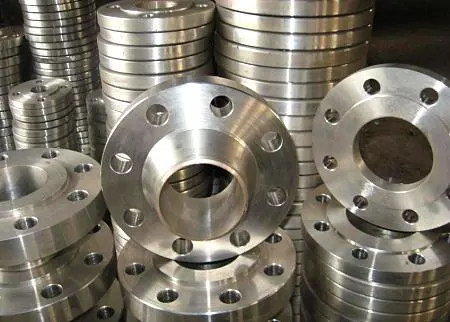An Introduction to the Welding Neck Flange
What is the welding neck flange? Welding neck flanges include long welding neck flanges, and raised face welding neck flanges, which are mainly used for the flange and pipe counterpart welding. Welding neck flanges have reasonable structures, good strength and high rigidity. They are able to withstand high temperature, high pressure, repeated bending and temperature fluctuations. They also have reliable sealing performance. Welding neck flanges with nominal pressure between 0.25Mpa and 2.5Mpa adopt the concave and convex sealing surfaces.
Generally speaking, welding neck flanges are flanges welded to pipes and with necks as well as the transition of round pipes. The welding neck flange is a kind of flanged fittings, having a wide range of use and promotion in different areas and industries. They have different use scopes and environments in application, but they must be used in accordance with certain conditions.
Welding neck flanges are suitable for steel pipe connections with nominal pressure not greater than 2.5Mpa. They play an important role and have great value in the pipeline connection, but the nominal pressure of them must be controlled in a certain range in use. The sealing surface of the welding neck flange can be made into smooth type, concavo-convex type and tongue & groove type. Welding neck flanges with smooth sealing surfaces are the most widely used flanges and are often used on the moderate medium conditions such as low-pressure non-purified compressed air and low pressure circulating water. They have the advantage of low price. Welding neck flanges are suitable for pipelines with great pressure or temperature fluctuations, high temperature pipelines, low temperature pipelines and high pressure pipelines. They can also be applied to pipelines which are used to transport expensive, flammable and explosive media.
At present, welding neck flanges have a wide range of use and promotion in the pipe fittings. We need to follow the appropriate method to use them because of the variety of application scope and environments.
The forging process of the welding neck flanges generally consists of the following steps: selection of excellent billet blanking, heating, forming and forging after cooling. Forging process methods include free forging, mold forging and fetal membrane forging. When in production, we select different forging methods according to the products' quality and lots of production.

Generally speaking, welding neck flanges are flanges welded to pipes and with necks as well as the transition of round pipes. The welding neck flange is a kind of flanged fittings, having a wide range of use and promotion in different areas and industries. They have different use scopes and environments in application, but they must be used in accordance with certain conditions.
Welding neck flanges are suitable for steel pipe connections with nominal pressure not greater than 2.5Mpa. They play an important role and have great value in the pipeline connection, but the nominal pressure of them must be controlled in a certain range in use. The sealing surface of the welding neck flange can be made into smooth type, concavo-convex type and tongue & groove type. Welding neck flanges with smooth sealing surfaces are the most widely used flanges and are often used on the moderate medium conditions such as low-pressure non-purified compressed air and low pressure circulating water. They have the advantage of low price. Welding neck flanges are suitable for pipelines with great pressure or temperature fluctuations, high temperature pipelines, low temperature pipelines and high pressure pipelines. They can also be applied to pipelines which are used to transport expensive, flammable and explosive media.
At present, welding neck flanges have a wide range of use and promotion in the pipe fittings. We need to follow the appropriate method to use them because of the variety of application scope and environments.
The forging process of the welding neck flanges generally consists of the following steps: selection of excellent billet blanking, heating, forming and forging after cooling. Forging process methods include free forging, mold forging and fetal membrane forging. When in production, we select different forging methods according to the products' quality and lots of production.

Related News
- Low-Temperature Flange Sealing Solutions for Cryogenic Chemical Pipelines
- Innovative Technology for Automatic Alignment in Underwater Flange Assembly
- Stamped Steel Slip-On Flanges
- Design and Finite Element Analysis of Anchor Flanges for Oil & Gas Pipelines
- Forming and Manufacturing Technology of Anchor Flanges
- Structure and Materials of Anchor Flanges
- Flanges for Pressure Vessels
- An Introduction to Socket Welded Neck Flanges
- Heat Treatment & Mechanical Properties of ASTM A350 LF3 Flanges (Part Two)
- Heat Treatment & Mechanical Properties of ASTM A350 LF3 Flanges (Part One)

